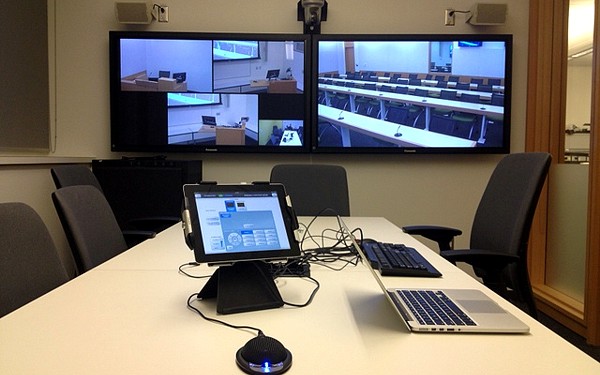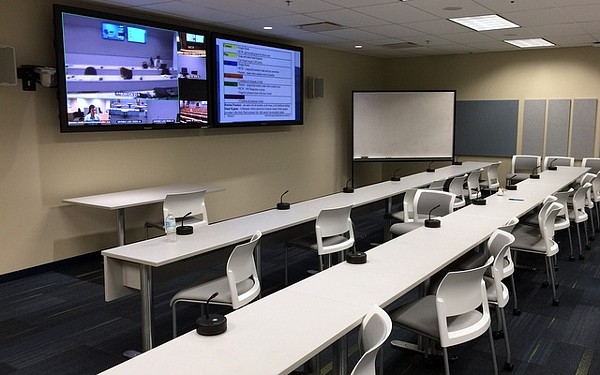
Main Page Related Pages A/V Systems Cluster Design for Intelligibility Intelligibility Calculator Loudspeaker Directivity Sound System Design Speech Intelligibility |
Video Conference Facility Design Video-conferencing has seen rapid growth as the digital age makes the data transmission between stations more economical and widely available. Where it was once necessary to rent or install expensive facilities to communicate using broadband video and satellite or fibre links, it can now be done using video codecs capable of operating over high bandwidth IP networks, and those systems can connect to even less expensive rollabout units, or even a desktop PC. Increasingly, the conventional "talking head" video conference installation is being extended with interactive elements that make the room more suitable to technical and engineering applications and collaborative design. These may include electronic white boards and host PC's for shared drawings or documents, and video input devices such as document cameras, document scanners, and slide to video converters. Combining video conferencing and computer data interconnection over the Internet can turn a video conference room into an effective workroom, or a situation room. The Elements of Video ConferencingA video conference facility is made up of the room, the video pickup and display component, the audio pickup and delivery system, and the codec (code/decode) that is used to convert the signals into a compressed digital form to be transmitted. While the codec and the available transmission bandwidth largely determine what the best transmitted audio and video signal quality can be, it is still important to design the other components for optimum performance. It is important to remember that when there is a requirement for upgradability the easiest item to improve is the codec and the network connection, so the design of the room, and the audio and video components should support foreseeable improvements in transmission bandwidth. The RoomThe video conference room has a tremendous impact on the audio and video systems used in that room. The room acoustics affects both the microphone pickup and the audio playback in the room. Where there is full duplex voice communication, the room acoustics are a critical element in minimizing the echo-cancellation problems, and potential feedback problems. HVAC noise, reverberation and reflections that may not be noticeable to a person seated in the room can be problematic when a microphone is opened in the room. A microphone does not have the sophisticated biological processing that the human brain has for ignoring unwanted sounds in favour of the important sounds. Ambient light affects the quality of the video display as well. Where there are reflections of light sources on the video display screen or lack of contrast caused by elevated ambient light levels the image quality will be significantly degraded. The Video SystemThe modern video conference system also makes extensive use of other video sources such as interactive computer presentations to augment the communication. This can be especially valuable for technical applications where models, drawings, sketches, and broken or defective parts can be shown to the receiving station. In addition to standard video sources, the use of interactive displays or collaborative computing software on tablets allow material displayed in the source room to be shared at the receiving end. Where a similar interactive computer is located in the receiving station, true interactive design, troubleshooting and problem solving can take place in near real time. Where the video conference room also functions as a meeting room, the video display for the video conference system can be made to double as the display for meeting support materials. The same document camera, as well as other video devices, can be used with these display systems. The Audio SystemThe audio system has four major components: one or more microphones (and mixer if required); the loudspeaker system; the video codec and digital phone hybrid that handles the signal processing allowing full duplex (two way) conversation and transmission/reception of the signals; and the acoustic echo cancellation (to prevent the source station hearing itself amplified and re-transmitted from the receive location). The performance of the entire audio chain is directly tied to the room acoustics. The performance of the echo cancelling is directly tied to the decay of sound in the room, and the quality of microphone pickup is likewise affected by early reflections and reverberation. This is the reason we emphasize the importance of room acoustics as part of the system design. Microphone placement plays an important part of the sense of distance between the talker and the receiving station. We are all familiar with the "group of people in a barrel" sound of a speaker phone. The speaker-phone sound results from a combination of an omni-directional microphone and hard surfaces in the room. The way to beat that tell-tale sound quality is by using appropriate microphones, getting the microphone closer to the talkers in the source room, and controlling the reflections from hard walls. This can help make a video conference sound like a cross-the-table meeting. The Control SystemThe control of the electronics associated with an elaborate video conference system can become cumbersome as the complexity of the system increases. Where a permanently installed video conference system is used, the control of lights, drapery, video and audio equipment becomes more complicated and interconnected. An integrated control system provides ready access to controls that are located in an equipment room, or simultaneously activates several related controls in the appropriate sequence. It can control cameras, switching, routing, and even video preview or cue monitoring when a colour touch screen control device is used. A touch screen interface has a major advantage in that it can be programmed in more than one language, and can be programmed to describe the functions in plain language. This reduces the learning curve, and the intimidation presented by high tech equipment. Where the proper communication protocols are available the control of the cameras and audio at the other station is possible. System DesignWe provide both room acoustics and the technical system design services for video conference facilities. In both retro-fits and new facility design, we work with; the architect or interior designer to provide recommendations for room layout, lighting guidelines and acoustical treatment; the Infomation Systems people (for data and network connectivityrequirements); and the users to develop a functional and effective facility that suits their needs.  |
